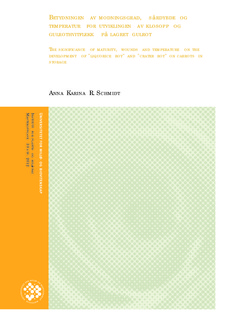| dc.description.abstract | Denne masteroppgaven omhandler utviklingen av plantepatogenene klosopp
(Mycocentrospora acerina) og gulrothvitflekksopp (Rhizoctonia carotae) på gulrot under langtidslagring. Det er blitt undersøkt hvordan faktorene sår i gulrotvevet (på 0, 1 og 3 mm dybde), alder på gulrøttene ved høsting (modningsgrad 1, 2 og 3 på henholdsvis 13, 16 og 20 uker), lagringstemperaturen (0-1, 3 og 5 °C) og lagringstiden påvirker sykdomsutviklingen.
Klosoppens råteflekker ble målt både i form av den bredeste diameteren på overflaten av gulrota og i form av råteflekkens utvikling innover i gulrotvevet. For gulrothvitflekksoppen
ble det kun registrert eventuell tilstedeværelse av symptomer i form av myceldotter.
For klosoppen indikerer resultatene at både modningsgrad, lagringstemperatur, lagringstid og sårdybde har signifikant betydning for utviklingen av bredden på råteflekken.
Bredden på råteflekken var signifikant størst for modningsgrad 3 (20 uker), mens
modningsgrad 2 (16 uker) viste de laveste verdiene. Det ble også vist en signifikant større bredde på råteflekkene med økende temperatur, økende sårdybde og økende lagringstid frem
til 14 uker. Resultatene antyder at en intakt periderm er en svært viktig faktor for å unngå infeksjoner av klosopp.
Råteflekkens utvikling innover i gulrotvevet ble signifikant påvirket av lagringstemperaturen og sårdybden. Mens råteflekkens utstrekning i bredden begrenses av lave temperaturer,
antyder dette forsøket at lave temperaturer og økt sårdybde kan føre råten lengre inn i gulrotvevet.
Gulrothvitflekksoppen viste seg først etter 20 uker. På grunn av en lav grad av etablering og en sakte utvikling var det for få registreringer for kjøring av regresjonsanalyse. Resultatene
antyder et økt angrep av gulrothvitflekksopp med økende temperatur og sårdybde. Det ble
observert flest tilfeller av gulrothvitflekk ved modningsgrad 2.
Sårdybden og modningsgraden til gulrøttene viser potensiale som faktorer for en tidlig estimering av lagringsevnen med tanke på angrep av klosopp, så lenge faktorene sees i sammenheng med ønsket lagringstid og lagringstemperatur. Abstract
The aim of this thesis has been to examine how the carrots maturity at harvest (maturity level 1, 2 and 3 at respectively 13, 16 and 20 weeks), wounding (at 0, 1 and 3 mm depth), storage temperature (0-1, 3 and 5 °C) and storage time effects disease development of “liquorice rot”
(Mycocentrospora acerina) and “crater rot” (Rhizoctonia carotae) on carrots during long time storage. The lesions of M. acerina were measured both as the diameter on the surface of the
carrot and as the development of the lesions towards the centre of the carrot. For R. carotae the disease was measured as presence of hyphal knots.
For M. acerina, the results indicate that the maturity of the carrot, the storage temperature, the time in storage and the depth of the wounds in the carrot tissue have significant importance for the development of the lesions diameter.
The diameter of the lesions was significantly larger for maturity level 3 (20 weeks), while maturity level 2 (16 weeks) showed the lowest values. Significantly larger lesions were also found with increasing temperature, increasing depth of the wounds and increasing time in
storage until 14 weeks. The results indicate that an intact periderm is important to avoid infections.
The development of the lesions towards the centre of the carrot was significantly affected by storage temperature and the depth of the wounds. While the diameter of the lesions is limited by low temperatures, the results in this study suggest that low storage temperature and increasing depth of the wounds may cause decay further into the carrot tissue.
The symptoms of R. carotae were first observed after 20 weeks of storage. Due to few observations and a slow development, there were too few recordings for a regression analysis.
The results indicate increased development of the disease with increasing temperature and depth of wounding. More symptoms were observed in the carrots of maturity level 2 than maturity level 1 and 3.
The maturity of the carrots at harvest and the depth of the wounds have potential for an early estimation of the storage capacity in relation to attacks by M. acerina, as long as the factors are considered in relation to the required storage time and temperature. | no_NO |
